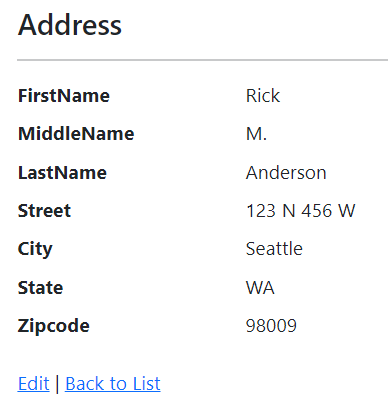Note
Access to this page requires authorization. You can try signing in or changing directories.
Access to this page requires authorization. You can try changing directories.
Display and Editor templates specify the user interface layout of custom types. Consider the following Address model:
public class Address
{
public int Id { get; set; }
public string FirstName { get; set; } = null!;
public string MiddleName { get; set; } = null!;
public string LastName { get; set; } = null!;
public string Street { get; set; } = null!;
public string City { get; set; } = null!;
public string State { get; set; } = null!;
public string Zipcode { get; set; } = null!;
}
A project that scaffolds the Address model displays the Address in the following form:

A web site could use a Display Template to show the Address in standard format:

Display and Editor templates can also reduce code duplication and maintenance costs. Consider a web site that displays the Address model on 20 different pages. If the Address model changes, the 20 pages will all need to be updated. If a Display Template is used for the Address model, only the Display Template needs to be updated. For example, the Address model might be updated to include the country or region.
Tag Helpers provide an alternative way that enables server-side code to participate in creating and rendering HTML elements in Razor files. For more information, see Tag Helpers compared to HTML Helpers.
Display templates
DisplayTemplates customize the display of model fields or create a layer of abstraction between the model values and their display.
A DisplayTemplate is a Razor file placed in theDisplayTemplatesfolder:
- For Razor Pages apps, in the
Pages/Shared/DisplayTemplatesfolder. - For MVC apps, in the
Views/Shared/DisplayTemplatesfolder or theViews/ControllerName/DisplayTemplatesfolder. Display templates in theViews/Shared/DisplayTemplatesare used by all controllers in the app. Display templates in theViews/ControllerName/DisplayTemplatesfolder are resolved only by theControllerNamecontroller.
By convention, the DisplayTemplate file is named after the type to be displayed. The Address.cshtml template used in this sample:
@model Address
<dl>
<dd>@Model.FirstName @Model.MiddleName @Model.LastName</dd>
<dd>@Model.Street</dd>
<dd>@Model.City @Model.State @Model.Zipcode</dd>
</dl>
The view engine automatically looks for a file in the DisplayTemplates folder that matches the name of the type. If it doesn't find a matching template, it falls back to the built in templates.
The following code shows the Details view of the scaffolded project:
@page
@model WebAddress.Pages.Adr.DetailsModel
@{
ViewData["Title"] = "Details";
}
<h1>Details</h1>
<div>
<h4>Address</h4>
<hr />
<dl class="row">
<dt class="col-sm-2">
@Html.DisplayNameFor(model => model.Address.FirstName)
</dt>
<dd class="col-sm-10">
@Html.DisplayFor(model => model.Address.FirstName)
</dd>
<dt class="col-sm-2">
@Html.DisplayNameFor(model => model.Address.MiddleName)
</dt>
<dd class="col-sm-10">
@Html.DisplayFor(model => model.Address.MiddleName)
</dd>
<dt class="col-sm-2">
@Html.DisplayNameFor(model => model.Address.LastName)
</dt>
<dd class="col-sm-10">
@Html.DisplayFor(model => model.Address.LastName)
</dd>
<dt class="col-sm-2">
@Html.DisplayNameFor(model => model.Address.Street)
</dt>
<dd class="col-sm-10">
@Html.DisplayFor(model => model.Address.Street)
</dd>
<dt class="col-sm-2">
@Html.DisplayNameFor(model => model.Address.City)
</dt>
<dd class="col-sm-10">
@Html.DisplayFor(model => model.Address.City)
</dd>
<dt class="col-sm-2">
@Html.DisplayNameFor(model => model.Address.State)
</dt>
<dd class="col-sm-10">
@Html.DisplayFor(model => model.Address.State)
</dd>
<dt class="col-sm-2">
@Html.DisplayNameFor(model => model.Address.Zipcode)
</dt>
<dd class="col-sm-10">
@Html.DisplayFor(model => model.Address.Zipcode)
</dd>
</dl>
</div>
<div>
<a asp-page="./Edit" asp-route-id="@Model.Address?.Id">Edit</a> |
<a asp-page="./Index">Back to List</a>
</div>
The following code shows the Details view using the Address Display Template:
@page
@model WebAddress.Pages.Adr2.DetailsModel
@{
ViewData["Title"] = "Details";
}
<h1>Details</h1>
<div>
<h4>Address DM</h4>
<hr />
<dl class="row">
<dd class="col-sm-10">
@Html.DisplayFor(model => model.Address)
</dd>
</dl>
</div>
<div>
<a asp-page="./Edit" asp-route-id="@Model.Address?.Id">Edit</a> |
<a asp-page="./Index">Back to List</a>
</div>
To reference a template whose name doesn't match the type name, use the templateName parameter in the DisplayFor method. For example, the following markup displays the Address model with the AddressShort template:
@page
@model WebAddress.Pages.Adr2.DetailsCCModel
@{
ViewData["Title"] = "Details Short";
}
<h1>Details Short</h1>
<div>
<h4>Address Short</h4>
<hr />
<dl class="row">
<dd class="col-sm-10">
@Html.DisplayFor(model => model.Address,"AddressShort")
</dd>
</dl>
</div>
Use one of the available DisplayFor overloads that expose the additionalViewData parameter to pass additional view data that is merged into the View Data Dictionary instance created for the template.
Editor templates
Editor templates are used in form controls when the model is edited or updated.
An EditorTemplate is a Razor file placed in theEditorTemplates folder:
- For Razor Pages apps, in the
Pages/Shared/EditorTemplatesfolder. - For MVC apps, in the
Views/Shared/EditorTemplatesfolder or theViews/ControllerName/EditorTemplatesfolder.
The following markup shows the Pages/Shared/EditorTemplates/Address.cshtml used in the sample:
@model Address
<dl>
<dd> Name:
<input asp-for="FirstName" /> <input asp-for="MiddleName" /> <input asp-for="LastName" />
</dd>
<dd> Street:
<input asp-for="Street" />
</dd>
<dd> city/state/zip:
<input asp-for="City" /> <input asp-for="State" /> <input asp-for="Zipcode" />
</dd>
</dl>
The following markup shows the Edit.cshtml page which uses the Pages/Shared/EditorTemplates/Address.cshtml template:
@page
@model WebAddress.Pages.Adr.EditModel
@{
ViewData["Title"] = "Edit";
}
<h1>Edit</h1>
<h4>Address</h4>
<hr />
<div class="row">
<div class="col-md-4">
<form method="post">
<div asp-validation-summary="ModelOnly" class="text-danger"></div>
<input type="hidden" asp-for="Address.Id" />
@Html.EditorFor(model => model.Address)
<div class="form-group">
<input type="submit" value="Save" class="btn btn-primary" />
</div>
</form>
</div>
</div>
<div>
<a asp-page="./Index">Back to List</a>
</div>
@section Scripts {
@{await Html.RenderPartialAsync("_ValidationScriptsPartial");}
}
Additional resources
ASP.NET Core
